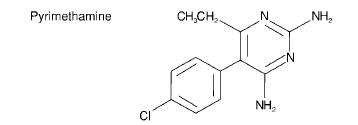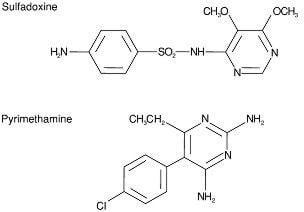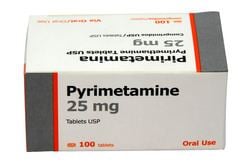Pronunciation /ˌpɪrᵻˈmɛθəmin/ AHFS/Drugs.com Monograph Routes ofadministration By mouth CAS ID 58-14-0 | Trade names Daraprim MedlinePlus a601050 Molar mass 248.71 g/mol Protein binding 87% | |
 | ||
Pregnancycategory AU: B3US: C (Risk not ruled out) | ||
Fractional distillation of lacquer thinner to obtain toluene
Pyrimethamine, sold under the trade name Daraprim, is a medication used with leucovorin to treat toxoplasmosis and cystoisosporiasis. It is also used with dapsone as a second line option to prevent Pneumocystis jiroveci pneumonia (PCP) in people with HIV/AIDS. It was previously used for malaria but is no longer recommended due to resistance. Pyrimethamine is taken by mouth.
Contents
- Fractional distillation of lacquer thinner to obtain toluene
- Vlog high school students beat ph d chemist to making pyrimethamine or daraprim
- Medical uses
- Toxoplasmosis
- Pregnancy consideration
- Malaria
- Contraindications
- Side effects
- Interactions
- Mechanism of action
- Other medications
- Mechanism of resistance
- History
- Availability and price
- Research
- References

Common side effects include gastrointestinal upset, severe allergic reactions, bone marrow suppression. It should not be used in people with folate deficiency that has resulted in anemia. There is concern that it may increase the risk of cancer. While occasionally used in pregnancy it is unclear if pyrimethamine is safe for the baby. Pyrimethamine is classified as a folic acid antagonist. It works by inhibiting folic acid metabolism and therefore the making of DNA.

Pyrimethamine was discovered in 1952 and came into medical use in 1953. It is on the World Health Organization's List of Essential Medicines, the most effective and safe medicines needed in a health system. In the United States in 2015 it was not available as a generic medication and the price was increased from 13.50 USD to 750 USD a tablet (75,000 USD for a course of treatment). In other areas of the world it is available as a generic and costs as little as 0.05 to 0.10 USD per dose.

Vlog high school students beat ph d chemist to making pyrimethamine or daraprim
Medical uses
Pyrimethamine is typically given with a sulfonamide and folinic acid.

It is used for the treatment of toxoplasmosis, actinomycosis, and isosporiasis, and for the treatment and prevention of Pneumocystis jirovecii pneumonia.
Toxoplasmosis

Pyrimethamine is also used in combination with sulfadiazine to treat active toxoplasmosis. The two drugs bind the same enzymatic targets as the drugs trimethoprim and sulfamethoxazole - dihydrofolate reductase and dihydropteroate synthase, respectively.
Pyrimethamine has also been used in several trials to treat retinochoroiditis.
Pregnancy consideration

Pyrimethamine is labeled as pregnancy category C in the United States. To date, not enough evidence on its risks in pregnancy or its effects on the fetus is available.
Malaria

It is primarily active against Plasmodium falciparum, but also against Plasmodium vivax. Due to the emergence of pyrimethamine-resistant strains of P. falciparum, pyrimethamine alone is seldom used now. In combination with a long-acting sulfonamide such as sulfadiazine, it was widely used, such as in Fansidar, though resistance to this combination is increasing.
Contraindications
Pyrimethamine is contraindicated in people with folate-deficiency anaemia
Side effects

When higher doses are used, as in the treatment of toxoplasmosis, pyrimethamine can cause gastrointestinal symptoms such as nausea, vomiting, glossitis, anorexia, and diarrhea. A rash, which can be indicative of a hypersensitivity reaction, is also seen, particularly in combination with Sulfonamides. Central nervous system effects include ataxia, tremors, and seizures. Hematologic side effects such as thrombocytopenia, leukopenia, and anemia can also occur.
Interactions
Other antifolate agents such as methotrexate and trimethoprim may potentiate the antifolate actions of pyrimethamine, leading to potential folate deficiency, anaemia, and other blood dyscrasias.
Mechanism of action
Pyrimethamine interferes with the regeneration of tetrahydrofolic acid from dihydrofolate by competitively inhibiting the enzyme dihydrofolate reductase. Tetrahydrofolic acid is essential for DNA and RNA synthesis in many species, including protozoa. Pyrimethamine has also been found to reduce the expression of SOD1, a key protein involved in amyotrophic lateral sclerosis.
Other medications
Pyrimethamine is typically given with Folinic acid and sulfadiazine.
Mechanism of resistance
Resistance to pyrimethamine is widespread. Mutations in the malarial gene for dihydrofolate reductase may reduce its effectiveness. These mutations decrease the binding affinity between pyrimethamine and dihydrofolate reductase via loss of hydrogen bonds and steric interactions.
History
Nobel Prize-winning American scientist Gertrude Elion developed the drug at Burroughs-Wellcome (now part of GlaxoSmithKline) to combat malaria. Pyrimethamine has been available since 1953. In 2010, GlaxoSmithKline sold the marketing rights for Daraprim to CorePharma. Impax Laboratories sought to buy CorePharma in 2014, and completed the acquisition, including Daraprim, in March 2015. In August 2015, the rights were bought by Turing Pharmaceuticals. Turing subsequently became known for a price hike controversy when it raised the price of a dose of the drug in the U.S. market from US$13.50 to US$750, a 5,500% increase.
Availability and price
In the United States, as of 2015, with Turing Pharmaceuticals' acquisition of the US marketing rights for Daraprim tablets, Daraprim has become a single-source and specialty pharmacy item, and the price of Daraprim has been increased. The cost of a monthly course for a person on 75 mg dose rose to about $75,000/month, or $750 per tablet. Outpatients can no longer obtain Daraprim from their community pharmacy, but only through a single dispensing pharmacy, Walgreens Specialty Pharmacy, and institutions can no longer order from their general wholesaler, but have to set up an account with the Daraprim Direct program. Presentations from Retrophin, a company formerly headed by Martin Shkreli, CEO of Turing, from which Turing acquired the rights to Daraprim, suggest that a closed distribution system could prevent generic competitors from legally obtaining the drugs for the bioequivalence studies required for FDA approval of a generic drug.
Martin Shkreli, CEO of Turing, defended the price hike by saying, "If there was a company that was selling an Aston Martin at the price of a bicycle, and we buy that company and we ask to charge Toyota prices, I don't think that that should be a crime." As a result of the backlash, Shkreli hired a crisis public relations firm to help explain his fund's move. Turing Pharmaceuticals announced on November 24, 2015, "that it would not reduce the list price of that drug after all", but they will offer various patient assistance programs. However, New York Times journalist Andrew Pollack noted that these programs "are standard for companies selling extremely high-priced drugs. They enable the patients to get the drug while pushing most of the costs onto insurance companies and taxpayers."
The price increase has been fiercely criticised by physician groups such as HIV Medicine Associates and Infectious Diseases Society of America.
In 2016, a group of high school students from Sydney Grammar supported by the University of Sydney prepared pyrimethamine as an illustration that the synthesis is comparatively easy and the price-hike unjustifiable. Shkreli said the schoolboys were not competition, likely because the necessary bioequivalence studies require a sample of the existing medication provided directly by the company, and not simply purchased from a pharmacy, which Turing could decline to provide.
In India, over a dozen pharmaceutical companies manufacture and sell pyrimethamine tablets and, multiple combinations of generic pyrimethamine are available for a price ranging from US$0.04 to US$0.10 each (3–7 rupees).
In the UK, the same drug is available from GSK at a cost of US$20 (£13) for 30 tablets (about $0.66 each).
In Australia, the drug is available in most pharmacists at a cost of US$9.35 (A$12.99) for 50 tablets (around US$0.18 each).
In Brazil, the drug is available for R$0.07 a pill, or about US$0.02.
In Canada, the drug was reportedly discontinued in 2013, but hospitals may make the drug in-house when it is needed. As of December 2015, Daraprim imported into Canada directly from GSK UK is available from an online pharmacy for US$2.20 per tablet.
On October 22, 2015, Imprimis Pharmaceuticals announced it has made available compounded and customizable formulations of pyrimethamine and leucovorin in capsules to be taken by mouth starting as low as $99.00 for a 100-count bottle in the United States.
Research
In 2011, researchers discovered that pyrimethamine can increase β-hexosaminidase activity, thus potentially slowing down the progression of late-onset Tay–Sachs disease. It is being evaluated in clinical trials as a treatment for amyotrophic lateral sclerosis.
